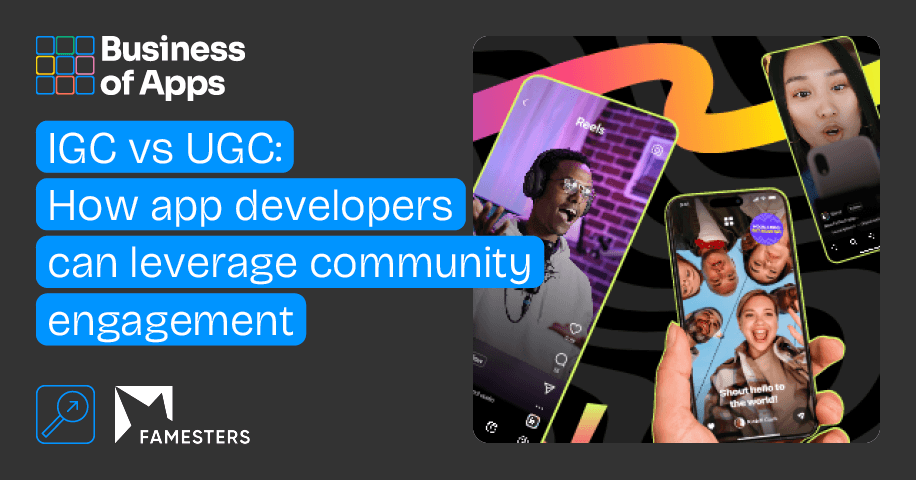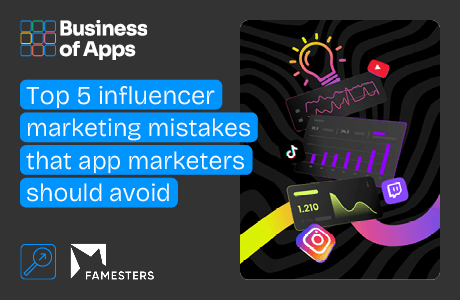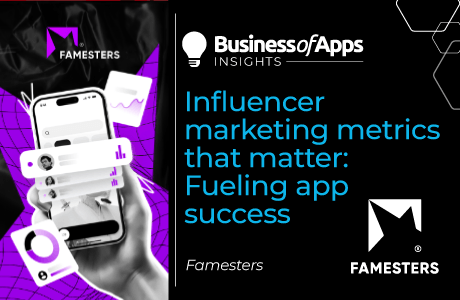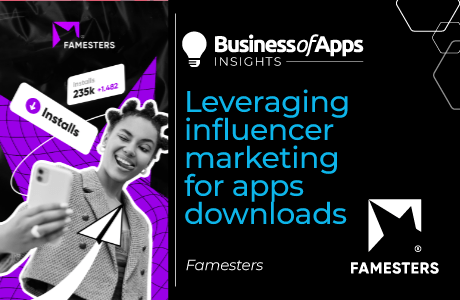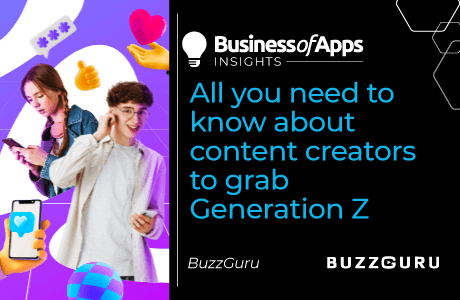When old-school ads fail to captivate and attract modern consumers, especially tech-savvy app users, community engagement stands as a pivotal element in the marketing strategies of successful apps. This engagement not only fosters a sense of belonging among users but also amplifies the visibility and appeal of an app in highly saturated markets. For app developers, understanding and harnessing this engagement can dramatically shift the landscape of user interaction, leading to greater app loyalty and broader user adoption.
Central to leveraging community engagement are two powerful strategies: User-generated content (UGC) and influencer-generated content (IGC).
UGC encompasses any form of content — be it reviews, testimonials, screenshots, or videos — created by users who are not compensated by the brands. This content is inherently trusted by peers due to its authentic nature, offering an unfiltered glimpse into the user experience.
On the other hand, IGC involves content created by influencers or thought leaders within the industry, who have significant followings and whose endorsements can carry considerable weight. This content, while usually sponsored, can vastly increase an app’s reach and credibility when done transparently and creatively.
The strategic integration of UGC and IGC not only enhances app visibility but also deepens user engagement and drives higher conversion rates. By tapping into these dual avenues, developers can create a multi-faceted marketing strategy that leverages the authenticity of user experiences and the persuasive power of influencers. In this article, the Famesters influencer marketing agency experts will help you explore how you can effectively employ UGC and IGC to build a robust community, increase app visibility, and ultimately, improve conversion rates.
What are UGC and IGC?
User-generated content
As mentioned previously, UGC refers to any content voluntarily created by users who interact with your app, without any compensation from the app developer. This could include textual content like reviews and comments, visual content like screenshots and videos, and even interactive content like forum posts and discussions. Reddit posts dedicated to some app, its features or updates can be examples of UGC content. The key characteristics of UGC include its organic nature, authenticity, and diversity, reflecting a wide range of user experiences and perspectives.
Examples of UGC in app marketing
- User reviews: Often found on app stores or social media platforms, user reviews serve as a powerful indicator of an app’s reputation. Positive reviews can enhance credibility, while a broad mix of reviews can provide valuable feedback for improvements.
- Gameplay videos: For gaming apps, users often post gameplay videos to showcase strategies, character builds, or levels they are particularly proud of. These videos not only engage other users but also act as free promotion of your app’s features.
- Social media posts: Users frequently share achievements or interesting in-app moments on their social media profiles, indirectly promoting the app to their friends.
Influencer-generated content
In contrast to UGC, IGC is created by individuals who have significant followings and whose opinions are highly respected within specific communities. These influencers are often compensated either monetarily or with other perks like exclusive access to app features. IGC is characterized by its strategic messaging and alignment with broader marketing campaigns. Also, IGC is usually of a higher quality as it’s created by professionals. The content is usually tailored to fit both the brand’s and the influencer’s image, aiming to strike a balance between promotional content and the influencer’s authentic voice.
Examples of IGC in app marketing
- Influencer collaborations: Partnering with influencers for app launches or feature updates can dramatically increase visibility. Influencers can create dedicated content explaining app features or offering tutorials on how to use the app.
- Sponsored app reviews: Influencers can provide detailed reviews of an app, discussing its features, usability, and benefits on platforms like YouTube, TikTok, Instagram, or blogs.
- Event coverage: If your app is involved in any events, influencers can cover these events live, providing their followers with insights into the app’s community and offerings.
For IGC, you can use any social media platform and content format — it depends on where your target audience is and what they find appealing: YouTube long videos, Instagram Reels, TikTok short videos, Twitch streams, Twitter threads, etc. Also, influencer posts made for promotion have to be marked as sponsored to maintain transparency.
Authenticity and trust reign
Whether dealing with UGC or IGC, the authenticity of the content plays a crucial role in its effectiveness. For UGC, the genuine, unscripted nature of the content can foster trust and reliability among potential users. For IGC, even though the content is more controlled, the influencer’s genuine and transparent presentation can significantly influence the audience’s perception of authenticity.
Trust is fundamental in digital marketing, as today’s consumers are increasingly savvy about sponsored content and can easily distinguish between forced and genuine endorsements. Hence, maintaining authenticity in both UGC and IGC not only helps in building trust but also ensures sustained engagement from the audience, reinforcing the overall credibility of the app.
The benefits of UGC for app developers
Cost-effectiveness and organic reach
One of the primary advantages of leveraging UGC is its cost-effectiveness. Unlike traditional advertising or influencer campaigns, UGC does not typically require a financial outlay; instead, it organically grows from the user’s genuine interactions and experiences with the app. You don’t buy UGC, you can only encourage and trigger it. This organic nature of UGC also extends its reach — each user’s content can influence their social circle through shares, likes, and comments, potentially creating a viral effect that significantly extends the visibility of your app without additional advertising costs.
Building trust and credibility through real user testimonials
Trust and credibility are crucial to the success of any app, and UGC can substantially enhance these elements. Real user testimonials and stories add a layer of authenticity that cannot be replicated by branded content. Prospective users are more likely to trust the opinion of their peers than the claims of an advertisement. By showcasing real experiences, app developers can transparently communicate the value of their app, which helps reduce scepticism amongst potential users and aids in overcoming barriers to adoption.
Enhancing user engagement and community feeling
UGC also plays a significant role in enhancing user engagement and fostering a sense of community. By encouraging users to create and share their content, developers not only keep their user base active and involved but also help them feel a part of the app’s community. This engagement is particularly crucial for apps that rely on continual user interaction, such as educational apps, lifestyle apps, or games. Engaged users are more likely to return to the app repeatedly, increasing retention rates and reducing churn.
Case study: Spotify Wrapped – Harnessing UGC for viral marketing success
Spotify Wrapped transforms annual user data into a compelling, shareable marketing campaign, exemplifying effective use of UGC to boost brand engagement and advocacy.
First launched in 2015, Spotify Wrapped provides annual personalized summaries of users’ listening habits, which include top songs, artists, and genres. This content is designed for easy sharing within the Spotify app and through email, encouraging widespread user participation.
Key operations:
- Data collection: Spotify tracks user interactions to gather detailed listening data.
- Data modeling: Analytical processes distill this data into personalized user statistics.
- Activation: Using Reverse ETL, Spotify delivers these stats in visually engaging formats that users can share on social media, turning them into brand promoters.
Success factors:
- Engagement: Spotify Wrapped leverages the authenticity of UGC, motivating users to share their unique musical journeys.
- Virality and FOMO: The campaign’s shareability and exclusivity drive viral marketing and attract new users.
Impact
The campaign significantly increases user engagement and app downloads annually, evidencing its effectiveness as a UGC-centric marketing strategy. In 2020, the campaign boosted Spotify downloads by 20%, and by 2022, it was estimated to have been shared over 100 million times on social media.
Spotify Wrapped showcases the power of using UGC to create personalized, engaging marketing campaigns that naturally encourage user interaction and brand growth. This strategy offers valuable insights for app developers looking to leverage similar tactics.
Leveraging IGC for broader reach and professional appeal
First of all, let the numbers speak for themselves: according to the research by Famesters (you can download it for free here), 66% of industry experts admit that IGC performs better or equally well as branded content.
How does influencer content perform vs brand-created content
Source: Famesters
IGC allows app developers to tap into the established audiences of influencers, offering a direct route to potential users who are already engaged and trust the influencer’s opinions. This targeted exposure is particularly valuable because it is highly specific; influencers often cater to niche markets or specific demographics that can align closely with your app’s target audience. By partnering with the right influencers, developers can significantly increase their app’s visibility among groups that are more likely to convert into active users.
Predictable scalability to reach the maximum of prospective users
IGC opens upscaling opportunities for apps and helps drive sustainable user growth. Partnering with influencers aids in reaching broad audiences and predicting how many people will see your ads – the more engaged and larger the number of followers, the better results to expect. Additionally, utilizing a multi-platform approach, partnering with multiple creators simultaneously, and recruiting influencers as brand ambassadors, all help expand and scale the app’s visibility.
Targeting opportunities for precise audience reach
In comparison with UGC, the utilization of IGC provides more precise targeting opportunities. While controlling the geo where UGC appears is challenging but possible, predicting the business results is almost impossible. Meanwhile, appealing to IGC allows for precise geo and audience targeting opportunities for brands, leading to controlled increases in brand awareness and, consequently, a boost in sales.
High-quality, professional content that reflects well on the app
IGC is typically of a higher quality and more polished than UGC, reflecting well on the professionalism of the app. Influencers are often experienced content creators who understand how to produce engaging, appealing content that resonates with their audience. This level of quality ensures that the app is represented in the best possible light, enhancing brand perception and potentially increasing the perceived value of the app. High-quality content also tends to be more shareable and can generate additional reach beyond the influencer’s immediate audience.
Strategic partnerships with influencers to drive app downloads and user engagement
Developing strategic partnerships with influencers can extend beyond simple sponsored content to involve deeper collaborations that can drive app downloads and user engagement. These partnerships might include exclusive features, early access to app updates, co-branded content, or even influencer participation in app development and feedback. Such collaborations can create buzz around the app and foster a sense of exclusivity and urgency, encouraging more users to download and engage with the app.
Case study: Babbel boosts paid subscriptions in Tier-1 countries
Founded in 2007, Babbel is a leading language-learning app with more than 1M active users. As an online company, it’s not surprising that Babbel’s marketing efforts are concentrated on digital channels, including partnering with influencers for user acquisition. To overcome challenges and get the best results possible, the Babble team sought assistance from Famesters.
Challenges:
- Increase the number of paid subscription purchases across Tier-1 countries
- Boost brand awareness
- Secure endorsements from reliable creators
Solution
The Famesters team selected the most relevant creators to collaborate with. With a carefully crafted strategy and a brief, the campaign quickly garnered 507,000 views and an average CPM of $74. Besides, the distribution of unique promo codes with a 50% discount on a lifetime subscription helped boost the number of users acquired in addition to influencers’ performance tracking.
Interested in diving deep into how Famesters helped Babbel acquire new users? Read the extended case here.
Strategies for combining UGC and IGC
Combining UGC and IGC can create a dynamic and robust marketing strategy that leverages the best of both worlds: authenticity and professional quality. Here’s how app developers can integrate these strategies effectively:
Integrating UGC and IGC for a comprehensive marketing strategy
- Cross-promotion: Use influencer content to inspire user-generated content. For example, launch a challenge or a contest where influencers demonstrate an activity using the app, and then ask your user base to create their own versions. This not only increases engagement but also amplifies the reach of both types of content.
- Feature integration: In your app, integrate features that encourage users to generate their own content and share it easily across their social networks, while also highlighting content created by influencers. This could be through an in-app gallery, social sharing functionalities, or user spotlights.
- Coordinated launches: Sync the release of new features or updates with IGC campaigns, encouraging both influencers and regular users to explore these updates through their content. This creates a wave of both professional and organic content surrounding new releases.
Balancing authenticity with professional quality
- Maintain transparency: Always disclose the nature of influencer partnerships and differentiate clearly between paid influencer content and organic user content. This maintains trust and credibility with your audience.
- Quality guidelines: Provide guidelines to influencers to ensure that their content aligns with your brand’s values and quality standards, but also encourage them to keep their unique voice to maintain authenticity.
- Curate UGC: Showcase high-quality user-generated content prominently to elevate the overall perception of your app’s community. Consider rewarding users whose content meets a high standard of quality and relevance.
Tips for encouraging UGC while engaging with influencers for IGC
- Reward both: Offer rewards for both influencers and regular users for creating content. While influencers might be compensated financially, consider providing app-related rewards (like premium features or in-app credits) to users.
- Engagement tools: Utilize tools within the app to facilitate content creation, such as templates, stickers, or customizable features that make it easier for users to create shareable content.
- Community features: Build and highlight features that allow users to follow each other, comment on content, and share within the app itself. This fosters a sense of community and encourages ongoing engagement.
Tools and platforms for managing and analyzing the impact of UGC and IGC
- Content management systems: Use a CMS to organize, approve, and publish user and influencer content efficiently. Platforms like Sprout Social or Hootsuite can help manage and schedule this content across various social media channels.
- Analytics tools: Tools like Google Analytics or social media native analytics features can track the performance of both UGC and IGC. Analyze metrics such as engagement rates, conversion rates, and the reach of content to measure effectiveness.
- User feedback platforms: Tools like Uservoice or Feature Upvote can help you gather user feedback directly related to the content or features of the app, providing insights that can drive content strategy adjustments.
By strategically combining UGC and IGC, you can maximize the impact of your content marketing efforts, enhancing user engagement, expanding reach, and building a community around your app. This holistic approach both enriches the user experience and promotes sustained growth and success in the app market.
Challenges and solutions for using IGC and UGC for app promotion
Managing inconsistent quality of UGC
Challenge: User-generated content varies widely in quality, which can affect brand perception negatively if low-quality content is prevalent.
Solution: Implement moderation tools or community guidelines to help maintain a standard of quality. Highlight exemplary UGC to set expectations for other users, and consider offering tutorials or tips on creating effective content.
Ensuring brand alignment and message consistency in IGC
Challenge: Ensuring that influencer-generated content aligns with the app’s branding and messaging can be difficult, especially when working with multiple influencers.
Solution: Develop clear, concise influencer briefs that outline brand guidelines, key messages, and desired outcomes. Here you can download a free influencer brief template crafted by the Famesters agency experts. Regularly communicate with influencers to ensure understanding and alignment, and review content before it goes live to catch any discrepancies.
Addressing potential legal issues around content ownership and use
Challenge: Navigating the legal complexities of using user-generated and influencer-generated content, such as copyright issues and rights to use the content for marketing.
Solution: Always secure explicit permission to reuse UGC for marketing purposes. For IGC, ensure contracts are clear about content ownership and usage rights. Consult legal expertise to draft user agreements and influencer contracts that protect your interests and clarify rights. You can also use this free influencer contract template by the Famesters influencer marketing agency.
Overcoming scepticism: Maintaining authenticity amid sponsored content
Challenge: Users are becoming more aware and sceptical of sponsored content, which can reduce the effectiveness of influencer marketing.
Solution: Encourage transparency from influencers about sponsorships. Blend sponsored posts with non-sponsored content to maintain a balance of authenticity. Utilize influencer relationships to create genuine and engaging content that resonates with both the influencer’s and your brand’s audience.
Future trends in UGC and IGC for app marketing
Increased demand for authenticity will lead to more nuanced influencer partnerships, focusing on long-term collaborations rather than one-off sponsored posts. Today, 61% of brands already prefer to work multiple times with the same influencers who perform well:
One-off vs “repetitive” influencer partnerships
Source: Famesters
Growth in micro-influencer and nano-influencer segments, as brands recognize the value of their highly engaged, niche audiences. 69% of brands already choose nano and micro-influencers over bigger names.
Types of influencers brands prefer to work with
Source: Famesters
AI will play a crucial role in curating and personalizing user-generated content at scale, ensuring users see content that is most relevant and engaging to them.
- Augmented reality will enhance how users interact with apps, offering new ways for them to create and share content. This technology can lead to innovative UGC campaigns that utilize AR for interactive and immersive experiences.
- As consumer values shift towards more privacy-focused and ethically conscious decisions, app developers will need to adapt their UGC and IGC strategies to align with these values.
- Staying ahead of technological advancements will be crucial. App developers must continually update their strategies to leverage new tools and platforms that facilitate content creation and sharing, ensuring they remain relevant and competitive.
Wrapping up
Leveraging UGC and IGC effectively can significantly enhance app visibility, engagement, and conversions. While UGC fosters authenticity and community trust, IGC offers more polished, far-reaching content that can attract a broader audience.
Combining these strategies allows you to capitalize on the strengths of both, creating a dynamic marketing approach that drives growth and user retention.
Staying adaptable and responsive to new trends in UGC and IGC will be key to maintaining relevance and achieving long-term success in the competitive app market.
If you are interested in building a successful strategy to promote your app or need more information on influencer marketing for mobile apps, contact the Famesters agency. Our experts are always ready to help.



